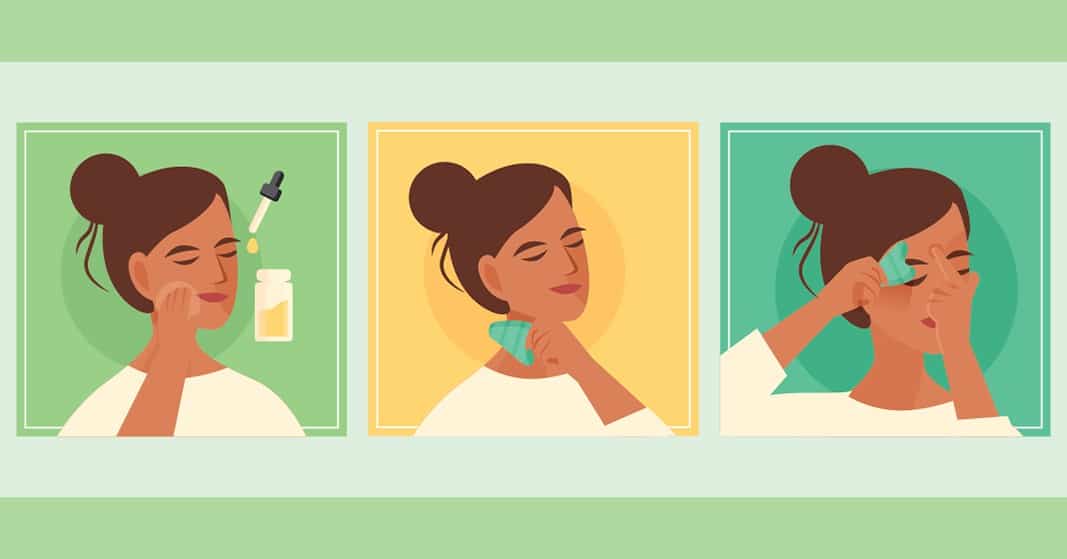Gua sha, a traditional Chinese medicine technique that dates back to the Han Dynasty (220 A.D.), has grown in popularity in recent years as a promising facial massage method because of its potential health benefits and skin perks. It’s no ordinary massage — the “scraping” technique may wash away more than just a dull complexion. Read on to learn more about gua sha, how it works, and how to try it at home.
What Gua Sha Means
Gua translates to scraping while sha means redness. Originally used as a medicinal treatment for heatstroke and illnesses, gua sha involved rigorously scraping skin until it reddened and sometimes bruised in order to release chi (also known as qi), or bad energy. In ancient Chinese medicine, the occurrence of disease depends on chi, and managing inflammation is believed to help balance the flow of chi. Traditionally, gua sha practitioners used any tool on hand, including animal bones, spoons, or coins. More recently, gua sha has been adapted for the skincare space with luxury tools made specifically for the face.
How it Works
While gua sha was once administered by someone else (and wasn’t limited to the face), modern gua sha often involves applying an oil to your face and then gliding a smooth stone over your skin in an upward, sweeping motion. The process — and potential benefits — is similar to using a jade roller. A gua sha facial tool can more effectively create friction against the skin and target specific areas with its angled curves. Researchers have linked regular gua sha facial massage to several health benefits, including:
- Reduced inflammation
Repeated massages can reduce inflammation and swelling (commonly caused by clogged lymph nodes). In one study on older individuals experiencing chronic low back pain, researchers suggest gua sha may have a significant anti-inflammatory effect. - Increased circulation
Massaging, especially in an upward and outward motion, encourages flow within the lymphatic system, a network of vessels, tissues, and organs. According to one pilot study, gua sha helps move lymph fluid through the lymph nodes to increase circulation. Research shows improved circulation can result in healthier, plumper looking skin by increasing the delivery of oxygen and nutrients to skin.
- Decreased muscle pain
Gua sha can alleviate muscle tension, whether that tension comes from stress, poor posture, or a headache. In one small study, participants experienced a significant improvement in chronic neck pain after one week of gua sha treatment.
- Increased immune function of the skin
Skin is an active immune organ and one of its main functions is to protect internal organs from toxins and physical stresses. In a study on mice, gua sha increased ratios of immune active cells in the skin tissue, effectively boosting its protective immune function.

Gua Sha Tools
The gua sha tool looks like a misshapen half-moon stone, commonly made from jade or rose quartz. While the type of stone isn’t as important to the treatment as the shape, ancient history associates gemstones with certain healing properties: Jade was thought to provide clarity of mind and rose quartz was believed to prevent aging.
Look for a tool with contours to fit the different angles of your face. Unlike a facial roller (which is shaped like a long oval) the smaller edges can better apply pressure to specific parts of the face such as the brow bone and eye area. The large base works best for cheekbones while the “v”-shape can be used for the jawline. Your gua sha tool should fit comfortably in your hand in order to glide it across your skin with sufficient pressure.
Conclusion
The ancient Chinese practice of gua sha has found its way into modern skincare, in part due to its potential health benefits and also because it’s an easy, affordable, and quick form of self-care. While gua sha is safe for most skin types, test out the technique — and any oils — before adding it to your daily routine. Redness and bruising can occur if the blood vessels near the skin’s surface burst, though a little color shouldn’t raise any concerns (traditional Chinese medicine believes skin redness demonstrates a healing response). If gua sha becomes painful, apply more gentle pressure.
